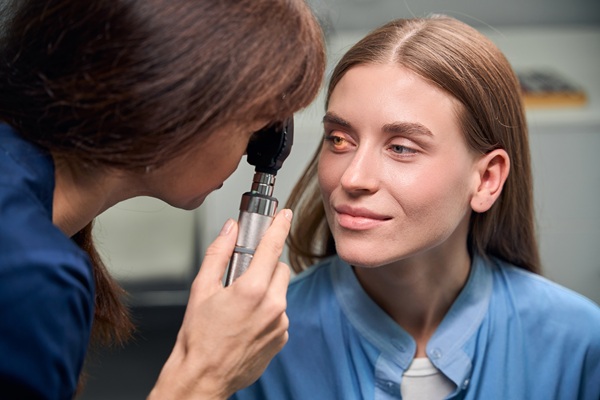How Does Prokera® Work?

Prokera® is a form of treatment prescribed by eye doctors to deal with moderate to severe issues of dry eye and related concerns. Prokera® devices contain an amniotic membrane attached to a polycarbonate ring. They slowly repair and heal the damaged surface of the eyes and provide comfortable relief to patients with dry eyes.
An overview of Prokera® treatment for dry eye
The following is an overview of Prokera, including a definition of Prokera, a review of how it works, when Prokera might be recommended by an eye doctor, and what you can expect throughout the treatment process. An eye doctor can provide more specific information on how Prokera might benefit you.
Prokera treatment for dry eye explained
Prokera is an eye repair device prescribed by eye doctors to treat more severe concerns of dry eye. The devices are held together by a polycarbonate ring. The secret to the success of Prokera in treating dry eye is the amniotic membrane. The patient can wear the Prokera devices the same as they would contact lenses, and they are placed by the eye doctor in the office. The symptoms of dry eye should improve over the course of several days.
Moderate-to-severe symptoms of dry eye
Prokera is recommended for patients that have moderate-to-severe symptoms of dry eye. These symptoms include:
- Eye pain
- Red eyes
- Burning eyes
- Itchy eyes
- Eye fatigue
- Distorted vision
If one or more of these symptoms worsens or exists for an extended period of time, then Prokera may be an appropriate treatment solution. This may be included with additional treatment methods such as lifestyle changes (e.g., more rest each night).
The safety and risks involved with Prokera
Severe side effects with Prokera are rare. However, there may be some discomfort that exists while the patient adjusts to the Prokera devices. The eye doctor can provide additional instructions for minimizing discomfort during the adjustment period. The Prokera membrane dissolves as the eye begins to heal. Follow-up visits are likely required to check on the progress and determine whether additional treatment is necessary.
How to begin the Prokera treatment process
The Prokera treatment process begins with a consultation with an eye care professional. During the visit, they can discuss the symptoms and make a professional recommendation as to how Prokera can benefit the patient. If the patient decides to move forward, then the Prokera devices can begin to be prepared. Once they are ready, the eye doctor can place them on the eyes and provide instructions for caring for the lenses and how to remove them, along with scheduling a follow-up visit.
FAQs about Prokera
To help you determine whether Prokera treatment is right for you and to help ensure the treatment process goes smoothly, here are answers to several frequently asked questions about Prokera:
Is Prokera safe?
Prokera has been approved by the FDA as a generally safe and effective treatment for certain eye-related symptoms and conditions. As is the case with almost all treatments, there are some potential side effects of Prokera, although complications are fairly rare. The most commonly reported side effects of Prokera include temporary blurred vision and mild discomfort while the patient adjusts to wearing the Prokera rings.
Does Prokera work as a stand-alone treatment?
Prokera is not intended as a stand-alone treatment for eye conditions. However, Prokera is considered a primary way to help deal with the root causes of conditions that lead to dry eye and related symptoms. Patients should only use Prokera treatment as approved by their eye professional as a part of a more comprehensive treatment plan. Most eye doctors recommend using Prokera along with good eye hygiene and lifestyle changes that may benefit the patient.
When can I remove the Prokera ring?
Once the amniotic membrane of the Prokera ring has dissolved, the ring can be removed from the eye. The time it takes for this can vary, ranging from three days to a little more than a week. When in doubt as to whether or not it is time to remove the Prokera ring(s), consult with your eye doctor.
Discuss Prokera treatment with an eye doctor
Are you struggling with issues of dry eye and have not found relief through over-the-counter eye products or lifestyle changes? If so, then Prokera might be the right solution for you. Schedule a consultation visit with our eye doctor today to discuss treatment goals and determine if Prokera should be a part of your treatment plan.
Get more information about Texas Optical in Dallas at https://www.texasoptical.net.
Check out what others are saying about our services on Yelp: Read our Yelp reviews.
Recent Posts
Red, itchy eyes can affect your everyday comfort and reduce overall well-being. It is important to seek effective vision care from the first sign of irritation. Proper attention to symptoms, underlying causes, and healthy habits ensures stronger long-term eye health and greater day-to-day clarity. Redness and itchiness often stem from several common triggers. These include: Allergic…
New spots or shadows drifting across vision can be unsettling, and sudden changes sometimes require emergency eye care to protect long-term sight. Many floaters are harmless, but others signal serious problems with the retina or internal eye structures. Understanding when floaters are normal and when they point to a true eye emergency helps patients act…
Glaucoma treatment plays a vital role in preserving vision and protecting the optic nerve from further damage. Many patients rely on daily eye drops to manage intraocular pressure, but these medications can sometimes come with side effects. Understanding how to recognize, minimize, and communicate about these effects supports long-term success and comfort with treatment. While…
Progressive lenses offer clear vision at near, arm's length, and far distances without the visible lines found in bifocals. They provide a smooth change in power from top to bottom, which means the eyes can focus comfortably throughout the day. With the right fit and guidance from an optometrist, progressive lenses help reduce eye strain…


